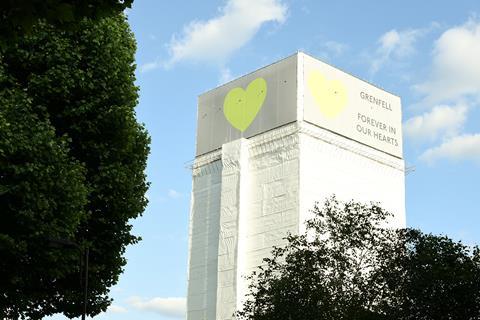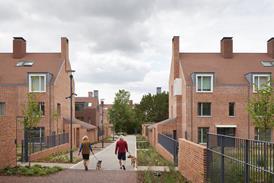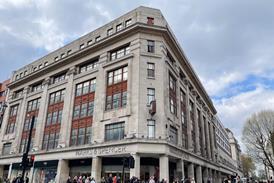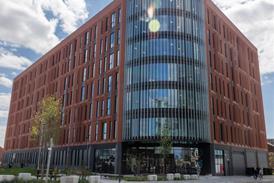RIBA warns of flaws in government’s draft Building Safety Bill
The government’s draft Building Safety Bill could leave architects liable for others’ work that is procured using design & build contracts, the RIBA has warned.
Architects could also be expected to sign off projects when they have no legal power to force a contractor to amend work they do not believe to be compliant.
The Building Safety Bill, the government’s response to the Hackitt Review following the Grenfell Tower fire that killed 72 people, would create dutyholders with legal responsibility for the safety of higher-risk buildings.

But the way these roles are currently structured could lead to conflicts of interest or the principal designer being expected to sign off work by the contractor they are novated to, warned the RIBA.
While the institute welcomed the introduction of dutyholders, it pointed to a series of flaws when widely used design & build contracts are in place.
It offered to work with the Ministry of Housing (MHCLG) to develop duties that could work across all procurement routes to provide effective building safety oversight.
Former RIBA president Jane Duncan, who is chair of the institute’s fire safety group, said: “The draft Building Safety Bill provides mechanisms to facilitate future regulatory change but, over two years on from the Hackitt Review, it’s still a long way from where it needs to be.
“The devil’s in the detail – and that’s exactly what‘s missing. We need clarification around the roles and responsibilities of ‘dutyholders’, measures to ensure permitted development schemes are fire-safe, and an appropriate definition of a ‘high-risk building’ – because fire does not discriminate.

“We urge the government to take note of our concerns and eagerly await clarification on secondary legislation. The longer this process continues, the longer people remain at risk.”
Her remarks came as the RIBA submitted detailed comments in response to the Housing, Communities and Local Government Select Committee’s call for evidence as it begins the process of scrutinising the bill.
>> Also read: What’s in the Building Safety Billl?
The RIBA’s key recommendations
- Ensure equal emphasis of responsibility is placed on all dutyholders, not just the Principal Designer and Principal Contractor, to ensure safety is embedded throughout the project.
Appropriate duties and competence requirements should be developed for all roles, including designers and contractors, so that responsibility and liability for managing health and safety risks rest with those who create them, as we cannot rely solely on Principal Designers and Principal Contractors to ensure building safety. This will provide the greatest opportunity for culture change in the industry, as proven by CDM 2015, and would leave no construction project without these necessary duties.
- Ensure new statutory duties can be delivered regardless of the procurement route – including projects procured through design & build where the Principal Designer and Principal Contractor roles may be provided by the same organisation.
The majority of ‘higher-risk buildings’ are procured using design & build or contractor-led contracts. If the intentions in the draft bill’s explanatory notes and the government response to the Building a Safer Future consultation are adopted, the Principal Designer would be required to co-sign a declaration of compliance with the Principal Contractor at gateway 3, to confirm that the building has been built in accordance with approved plans of gateway 2.
This requires review, as site inspection duties are thus effectively imposed on a Principal Designer, who may not have contractual or statutory powers to enforce changes to design or constructed works.
Following the CDM 2015 model, only the client can appoint a Principal Designer and a Principal Contractor and the criminal liability for these duties cannot be passed on in a sub-contract. Therefore under design & build procurement, the main contractor is both Principal Designer and Principal Contractor, as the client would only appoint one organisation to carry out design and construction services following the tendering process. Where the roles of the Principal Designer and Principal Contractor are provided by the same organisation, there will therefore be no independent sign-off provided by a third party other than the regulator.
If it were made possible to novate a Principal Designer, then there still would be conflict of interest in carrying out their duties during construction as they would be under contract to the Principal Contractor, rather than being appointed directly by the client. This conflict would be similar to allowing clients to choose and pay their own Approved Inspector, which will be removed under current proposals.
If the MHCLG decide to remove the conflict of interest in design & build procurement by requiring the Principal Designer and the Principal Contractor to be separate organisation, then it is likely the Principal Designer role will be contracted similarly to the now abandoned CDM Coordinator, who was a separate health and safety advisor not part of the design team and unable to provide truly effective health and safety design coordination. The Principal Designer provides building safety design coordination and leadership during the preconstruction phase, and the RIBA recommends that the Principal Designer should not be responsible for any other designer’s or contractor’s work.
The RIBA recommends that the Principal Contractor should take responsibility for the construction and be required to demonstrate to the Building Control Authority that the project has been built in accordance with the approved plans, and the Principal Designer should be responsible for coordinating building safety design information.
- Ensure dutyholders are in place for the gateway 1 planning application so that clients are required to appoint competent designers and a Principal Designer.
If planning gateway 1 occurs before dutyholders are required to be in place this may allow for projects to be developed by designers who do not meet the competency requirements, without a Principal Designer. Once planning approval has been obtained any fire safety issues that were not addressed in the layout of the building, reviewed by the regulator for fire safety, are likely to result in an amendment of the approval. The design at gateway 1 should be robust enough to be further developed for gateway 2 without the need to alter or overly engineer the design to meet building regulations. Fire safety should be a fundamental consideration at the early stages of the project.
- Ensure permitted development schemes pass through the gateway 1 regulatory submission, so that key building safety design parameters are met at this stage and competent dutyholders are in place.
Permitted developments will not be required to pass through gateway 1 which means the crucial review of proposals by the Building Safety Regulator for fire safety at this stage will be missed… Amend the permitted development rules to require any developer of a building that is, or following a development will become, a higher-risk building to apply to the local planning authority for a determination as to whether prior approval will be required in relation to the fire safety.
- Ensure a reduction of the height threshold to 11m and a widening of the scope of the definition of a ‘higher-risk buildings’ at the outset so that the new regime also applies to non-residential buildings including hospitals, care homes, hospices, schools, hotels, hostels, guesthouses and prisons during the design and construction phases.
- Ensure the Bill does not disrupt progress of the urgent review of Approved Document B to provide the industry with clear, unambiguous guidance.
Source: Edited extracts from RIBA’s response to the Commons Housing, Communities and Local Government Select Committee
















3 Readers' comments